Content
- Peculiarities
- Botanical description
- Kalanchoe Degremona
- Kalanchoe pinnate
- What parts are used for medicinal purposes
- Collection
- How to prepare
- Compound
- Medicinal and useful properties
- For women
- For men
- For children
- Potential harm
- Contraindications
- Traditional medicine recipes
- Cold, flu
- Sore throat, throat and oral cavity diseases
- Rhinitis, sinusitis
- Sinusitis
- Otitis
- Avitaminosis
- Skin problems
- Cosmetic defects
- Kalanchoe ointment
- Diseases of the eyes
- Phlebeurysm
- Diseases of the gastrointestinal tract
- Video about Kalanchoe
Kalanchoe - familiar to many home plant with unusual leaves and beautiful flowers. Its medicinal properties are well known to official medicine, and are also successfully used in home treatment. The juice from Kalanchoe leaves is a part of pharmaceutical preparations for colds, vascular pathologies, diseases of the digestive system, dermatological problems. At the same time, home remedies are not inferior in efficiency to pharmacy extracts and have extremely low toxicity.
Peculiarities
Kalanchoe (Kalanchoe) is the name of a whole genus of succulent plants from the Tolstyankov family. The ability to store water and valuable substances in the leaves and stems determines the unusual appearance of all its representatives. More than 200 species of Kalanchoe are known to science. Most of them can be found in the southern latitudes of Africa, Asia, Australia, and the Pacific islands.
The name Kalanchoe came from China and literally means "viviparous". The name describes the ability of the plant to lay brood buds at the edges of the leaves. By the end of the growing season, these shoots have their own leaves and roots, and crumbling, quickly take root.
Botanical description
Kalanchoe are succulent perennials with herbaceous stems and highly branched superficial roots. The aerial part is smooth, completely covered with a thin bluish bloom. All green mass is capable of accumulating moisture, therefore, under optimal growth conditions, it is juicy and fleshy.
The erect stem can grow up to 1 m in height. The average size of indoor specimens is about 50 cm. Kalanchoe stems are cylindrical, smooth. The leaves are cross-paired, sitting on long petioles. The lower plates are larger, ovoid with pronounced teeth. The upper ones are complex, have from 3 to 5 serrated leaflets.
Kalanchoe flowers are collected in paniculate inflorescences of a greenish hue. The fruits ripen extremely rarely and are 4 small leaflets. Kalanchoe is propagated both by seeds and by vegetative methods. In indoor conditions, the most convenient way of growing from brood buds.
Kalanchoe, whose medicinal properties and application do not depend on the method of cultivation, are cultivated in the open air in the south of Russia, in Georgia, in the Ukraine. Succulents also tolerate indoor cultivation well, therefore they are distributed throughout the world. But the most valuable from a medical point of view are only two types.
Kalanchoe Degremona
Kalanchoe daigremontiana has a pointed leaf shape with pronounced jagged edges. The gray-green plates are shaped like crocodile faces. 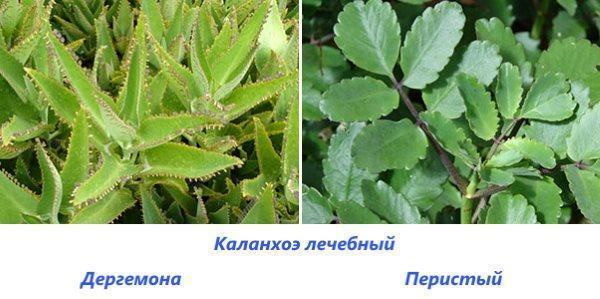 The Degremon species is most in demand in home floriculture.
The Degremon species is most in demand in home floriculture.
Kalanchoe pinnate
Kalanchoe pinnata has rounded leaves, and the teeth are also rounded at the edges. The plant is larger. The height of the indoor pinnate Kalanchoe can reach 100 cm. The color of the plates and stems is pale green.
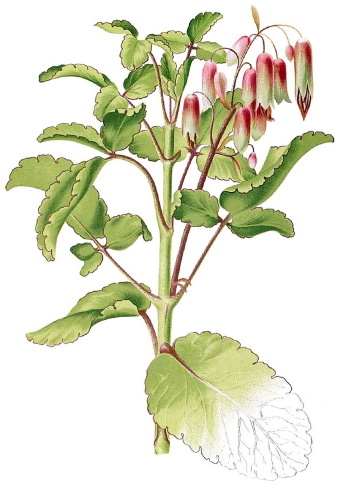
These types are used to obtain medicines or home remedies. The rest of the Kalanchoe species are mainly used for decorative purposes.
What parts are used for medicinal purposes
Any leaves and young stems of Kalanchoe are considered medicinal raw materials. In industrial harvesting, the shoots are harvested entirely. At home, only adult plates are cut from the bottom of the bushes.
For medicinal purposes, juicy, fleshy leaves and healthy, smooth stems are chosen. The upper part of the plates is green, the lower part is bluish, the petioles are reddish. Kalanchoe stems should be evenly colored, without spots or dried out areas. Fresh raw Kalanchoe produces a faint aroma. The sap of the plant has a slightly astringent, sour taste.
Collection
On industrial plantations, Kalanchoe is cut twice per season. Each time, the bushes are allowed to grow new young shoots. In this case, flowering does not occur, and the culture is cultivated in a one-year cycle.
Home Kalanchoe bushes live for many years. Raw materials for medicinal compositions are collected carefully so as not to harm the plant. Cut off mature leaves from the bottom of the bush. If necessary, harvest whole shoots, but try not to remove more than 1/3 of the entire green mass.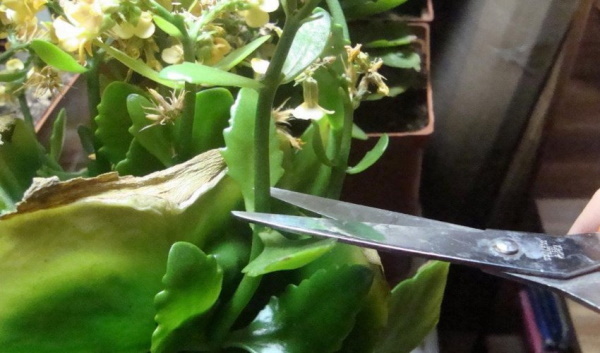
Kalanchoe bushes, intended for medicinal purposes, cannot be fertilized with mineral compounds. 7 days before cutting the raw material, it is recommended to stop watering and feeding.
How to prepare
Kalanchoe provides healing properties and use as a medicine only with proper processing of raw materials. Drying the leaves, as is the case with other beneficial herbs, does not make sense. The most valuable thing in Kalanchoe is its juice. It has a high biological activity, but it quickly deteriorates. Therefore, the preparation, as well as the storage of raw materials, are especially attentive.
Harvesting Kalanchoe juice:
- Cut leaves or shoots of Kalanchoe are washed with running water, dried and placed in a paper bag.
- Then the bundle is wrapped in plastic wrap and placed in the refrigerator. It is advisable to use a storage space for vegetables.
- Leave the raw material in the cold for about 7 days. During this time, additional fermentation takes place, enhancing the medicinal properties.
- The leaves can then be removed and used.
If you need urgent help, Kalanchoe can be applied immediately after cutting from a bush. But traditional medicine has many ways of preparing medicines from fermented raw materials.
Decoctions, infusions, alcohol extracts, as well as ointments or additives to cosmetics are prepared from Kalanchoe. But the most valuable is the juice from properly prepared leaves and stems.
Juice preparation and storage rules:
- With a large amount of raw materials, it can be passed through a meat grinder and squeezed out the valuable moisture from the resulting mass through several layers of gauze.
- The juice is poured into a sterile dark glass bottle. When using transparent dishes, be sure to wrap them in paper. Any light is detrimental to the biologically active components of the Kalanchoe.
- The bottle is tightly sealed and placed in the refrigerator.
- After 2-3 days, the liquid is drained from the precipitate that appears and filtered.
- The resulting clear juice is used in pure form or diluted with water for different recipes.
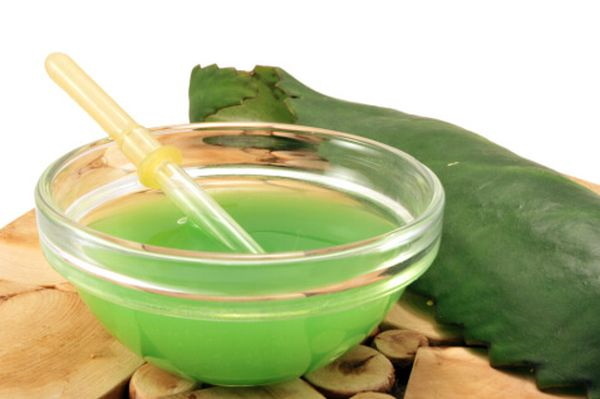
Store the Kalanchoe pomace in the refrigerator. A pure preparation loses its properties after 2 weeks, therefore, for long-term use, it is preserved with alcohol. It is advisable to take 70% alcohol in a ratio of 1: 5 to the amount of juice. Such a medical preparation can be stored for up to 1 year in a cold place.
Compound
The entire aerial part of the Kalanchoe contains about 90% moisture. The sap of the plant has a rich composition. In addition to vitamins, trace elements and common plant components, it contains unique substances used in medicine.
Kalanchoe composition:
| Micro and macro elements | Manganese, silicon, aluminum, iron, potassium, copper, iron |
| Vitamins | Ascorbic acid and flavonoids from the vitamin P group: zhalin, kaempferol, quercetin |
| Enzymes | Lectins and derivatives of acetic, malic and oxalic acids |
| Glycosides | Bersaldegenin, bryophylline (C and A) |
| Polysaccharides | Make up to 40% of the dry weight of the plant |
| Other valuable compounds | Tannins, hydrochloric acid, organic acids |
Scientists have isolated an antiviral substance from Kalanchoe, which stimulates the production of compounds like interferon in the body. This factor is capable of neutralizing the polio virus, which makes it possible to use extracts in the creation of vaccines.
Medicinal and useful properties
Kalanchoe (medicinal properties and applications are described in this article) is used not only in home medicine. Science has proven the antibacterial and disinfecting effect of fresh as well as fermented juice. At the same time, an effect was found on both gram-positive and gram-negative bacteria. The hood is capable of disinfecting water from natural sources, destroying enteroviruses, mold spores, and other biological contaminants.
Kalanchoe exhibits the following properties for the body:
- anti-inflammatory agent;
- biogenic stimulant;
- natural antibiotic;
- antiviral factor;
- wound healing, hemostatic agent.
With its low toxicity, Kalanchoe juice is able to cleanse purulent wounds, stop necrotic processes, heal external varicose, trophic ulcers and scar internal lesions of the gastrointestinal tract. The regenerating, disinfecting properties of the juice are used against bedsores, as well as in the treatment of postoperative sutures.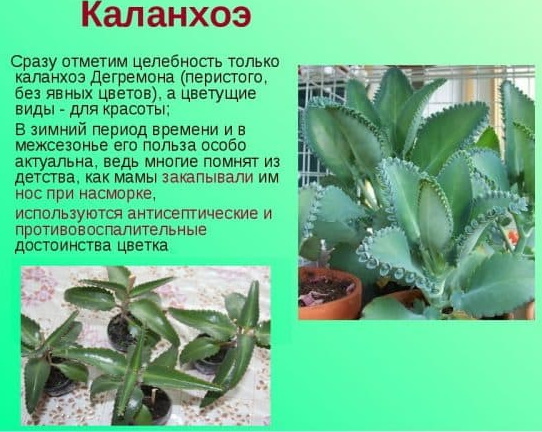
Range of application of Kalanchoe:
- Ophthalmology: burns, erosion, keratitis, degenerative changes, infection (including the herpes virus).
- Gastroenterology: enterocolitis, gastroduodenitis, gastritis, ulcerative lesions of the intestine and stomach.
- Otorhinolaryngology: all types of sinusitis, rhinitis, sinusitis, otitis media, tonsillitis, laryngitis, flu.
- Dentistry: periodontal disease, stomatitis, abscesses and purulent fistulas in the oral cavity.
- Dermatology: furunculosis, acne, wounds (including infected), burns, eczema, psoriasis.
For medical purposes, Kalanchoe preparations are produced in the form of juice and laniment (extract dried to a powder state). Officially, these funds belong to the group of wound-healing, anti-inflammatory drugs.
For women
Kalanchoe juice is often used in home cosmetology to cleanse, rejuvenate the skin and even out complexion. Preparations from the plant are used to treat the skin to maintain elasticity and prevent stretch marks. Lotions made from juice or pulp can help cure mastitis.
Taking Kalanchoe inside is not recommended for pregnant women. Topical application in the form of nasal drops or rinses is allowed after consultation with your doctor. External use is harmless in the absence of an allergic reaction to the plant.
After childbirth, Kalanchoe juice is used to treat tears, seams, postpartum erosion. The product disinfects and at the same time accelerates healing. When breastfeeding, the pure sap of the plant can quickly relieve inflammation and heal cracked nipples.
For men
During the treatment of urological problems, as well as for the prevention of prostate problems, Kalanchoe alcohol extract is used. The extract is taken orally in small doses to eliminate erection problems or in the complex treatment of impotence.
To prepare, you need ½ cup of leaves and 1 liter of high-quality strong alcohol. The agent is insisted for 10 days, then filtered and stored in a dark, cool place. Drink 20 ml of tincture per day, provided that alcohol is compatible with drugs from the official course of treatment.
For children
Kalanchoe rarely causes allergic reactions. However, before the first use in children, the plant should be tested for tolerance. To do this, one drop of juice is applied to the skin area in the hollow under the nose. If redness or rash does not appear within a few hours, then the agent can be used for instillation.
Most often, Kalanchoe is a safe remedy for nasal congestion for babies. For rhinitis, colds, infectious diseases, the juice is instilled 1-2 drops into each nasal passage. Reflex sneezing, which occurs in response to Kalanchoe, additionally helps to rid the passages of mucus.
For babies, it is enough to carry out the procedure three times a day. It is not recommended to treat rhinitis in this way for more than 3 days.
For children under 12 months old, Kalanchoe juice must be diluted with boiled water 1: 2. Already from the age of one, it is allowed to use the product in its pure form.
Potential harm
Kalanchoe, shows medicinal properties with virtually no side effects or danger of overdose. However, its use should still be dosed carefully. An excess of the Kalanchoe preparation does not pose a threat to life, but it can cause unpleasant symptoms from the gastrointestinal tract, the vascular system, and lead to desiccation of mucous membranes.
Side effects with prolonged use of Kalanchoe or overdose:
- diarrhea;
- heartburn;
- burning of the skin;
- dryness and cracks in the skin;
- nosebleeds with abuse of drops.
In the absence of an allergy to Kalanchoe, the drugs are well tolerated by people of any age.
Contraindications
Despite its non-toxicity, Kalanchoe has a number of restrictions on its intake.
It is not recommended to use drugs inside for such health problems:
- Presence of benign or malignant neoplasms.
- Tendency to pressure surges or chronic hypotension.
- Serious decrease in liver function, hepatitis, cirrhosis.
- Rheumatic diseases of the joints.
- Whipple's disease.
- Homerulonephritis.
- Bronchial asthma.
- Uncompensated diabetes mellitus.
It is recommended to abandon the internal intake of Kalanchoe for the entire period of pregnancy and lactation.
Traditional medicine recipes
Home treatment of rhinitis with Kalanchoe juice is a familiar, common recipe. But the plant has a wider application and is able to provide assistance in various conditions. Traditional medicine offers many recipes for the treatment of a wide variety of diseases.
Cold, flu
For such diseases, you can prepare a mixture with honey for internal use and drink, regardless of the presence of rhinitis or nasal congestion. The tool stimulates the immune system, and in the early stages it can stop the development of the disease.
Kalanchoe juice with honey:
- Mix pure pomace of leaves with honey in equal parts.
- Take 1 tbsp. l. Twice a day on an empty stomach.
- It is advisable not to eat for another 20 minutes after using the product.
In addition to stimulating the production of its own interferons, Kalanchoe with honey ensures the supply of minerals and vitamins to a weakened body. This not only speeds up recovery, but also helps to recover from illness. Therefore, the remedy continues to be taken for another 5 days after the symptoms disappear.
Sore throat, throat and oral cavity diseases
For gingivitis, stomatitis, periodontal disease, redness of the throat, inflammation of the tonsils, Kalanchoe is used in the form of rinsing. To do this, it is convenient to prepare a tincture for alcohol and dilute the product as needed. Rinse is prepared with 100 ml of lukewarm water and 1 tsp. l. alcoholic extract of Kalanchoe. You can use pure juice for the same purposes. To do this, the pomace is diluted in half with boiled water.
Pure juice is used for severe inflammation of the gums, soaking cotton swabs. Lotions are placed on the affected areas and left for up to half an hour. The procedure reduces bleeding, reduces pain, itching, and edema. Lotions are repeated no more than 4 r per day.
Rhinitis, sinusitis
For nasal congestion, a classic Kalanchoe recipe is used. For this, pure juice is used for adults, for children under 7 years old, it is diluted in half. A few drops are instilled into each nostril per procedure.
For people with fragile vessels, use the product no more than 3 times a day and dilute it to a child's concentration. Violent sneezing can lead to nosebleeds. Instillation can be replaced by wetting the nasal passages with a turunda or a cotton swab.
Sinusitis
A more aggressive composition is required to treat inflammation in the maxillary sinuses. For this, Kalanchoe is combined with aloe and onions.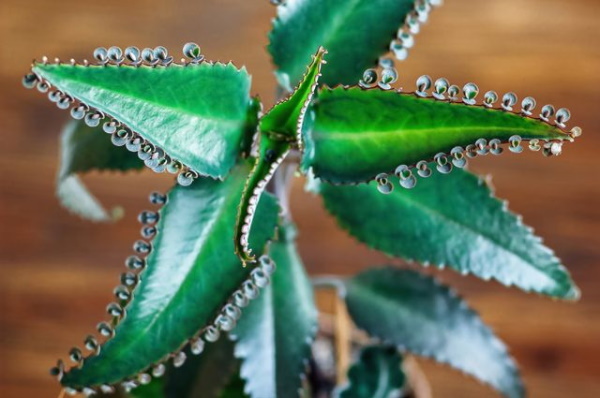
Preparation:
- Aloe juice is prepared similarly to Kalanchoe pomace. Measured in 2 tbsp. l. liquids and mix in a small ceramic bowl.
- Add 1/4 tsp. l. onion juice. The container is covered with a lid and used for no more than 3 days, provided that it is stored in the refrigerator.
- 4 drops are instilled into each nasal passage no more than 2 times a day.
For the effectiveness of the drug, the head is laid horizontally before the procedure. First, the right nostril is buried with the head resting on the left ear. Wait ½ hour for the medicine to penetrate into the sinuses. Then do the same with the left nasal passage, turning the head in the opposite direction.
Otitis
In case of an inflammatory process, pain or a lumbago in the ear, it is recommended to soak cotton turunda with Kalanchoe juice and put it in the ear canal for several hours or at night. The tool is auxiliary. It can be used to relieve pain and inflammation during formal treatment.
It is also recommended to make vodka compresses:
- Mix vodka and juice in equal parts or dilute the finished tincture in half with water.
- A gauze cut folded several times is moistened in a solution.
- Apply to the sore ear and cover the compress with polyethylene.
A warming bandage is arranged on top, and then left to warm up for 30 minutes. After the procedure, it is not recommended to go outside, therefore compresses are most often applied in the evening, before bedtime.
Avitaminosis
The tool well restores mental and physical performance, can be used as an additional source of vitamins and valuable mineral compounds. A simple recipe involves collecting 1 tsp. l. brood buds (babies) from Kalanchoe leaves and take them orally, chewing like a salad.
This amount is enough to restore the body, improve the composition of the blood. The tool is used in the treatment of male and female diseases to enhance the effect of official medicines. Kalanchoe buds can be used for quite a long time. With an abundance of raw materials, it can be continued for several months in a row.
Skin problems
For dermatological diseases or injuries, pure Kalanchoe juice is most often used. Simply rubbing it into the skin treats warts, shingles and herpes. The extract can be used to enrich cosmetic creams and medicinal ointments. After kneading a freshly torn leaf, it is permissible to immediately use it as a lotion to a cut or bruised place.
Kalanchoe has a very wide spectrum of efficacy for skin lesions. It is considered a universal remedy for such problems. In case of burns, rashes, dermatitis, diathesis, eczema, bedsores, wounds, ulcers, purulent inflammations, it is enough to moisten gauze napkins with Kalanchoe juice and apply to sore spots.
You can also grind the plant into gruel, place it between layers of gauze and apply it to the affected skin. Lotions are periodically replaced with fresh ones. Treatment continues until complete recovery.
Cosmetic defects
For acne, painful acne, as well as to reduce scars or pigmentation, Kalanchoe leaves are used. The skin is removed from the plate and the places of defects are wiped. Then cream or makeup is applied. Repeat the treatment after each wash.
Another way to care for problem skin is to use a homemade Kalanchoe lotion.
Preparation:
- The Kalanchoe leaves are finely chopped and measured in 2 tbsp. l.
- Pour raw materials with a glass of boiling water.
- Defend the remedy for about 2 hours.
- Filter the product and squeeze the steamed leaves.
- The prepared lotion is used to wipe the face in the morning and before bedtime, immediately after washing.
To treat deep dermatological problems, several courses of infusion may be required. Kalanchoe lotion not only cleanses the skin and polishes skin irregularities, but also preserves its youthfulness, improves turgor and complexion.
Kalanchoe ointment
The basis of this preparation is a boiled infusion of Kalanchoe. The product can be used for any dermatological lesions without damaging the integrity of the skin.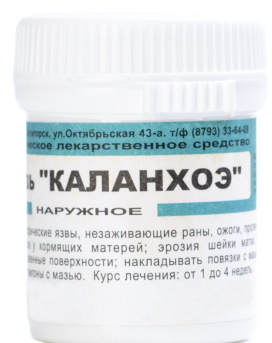
Preparation:
- The infusion prepared according to the lotion recipe is evaporated in half in a water bath.
- This extract can be stored longer than the juice. It is taken orally, diluted with water 1: 1.
- To prepare the ointment, the extract is cooled to a slightly warm state, then 20 ml of the solution is measured.
- Combine the infusion with lanolin (50 ml) and petroleum jelly (50 ml) in a ceramic container. Mix the composition thoroughly.
The finished ointment is transferred to a glass container with a tight lid. The product retains its properties when placed in the refrigerator for about 20 days.
Kalanchoe medicinal properties and application for psoriasis is best shown in combination with honey. For 1 hour l. juice take 1 tsp. l. liquid honey and 3 tsp. l. water. Stir the agent thoroughly, insist for 3 days and moisten the affected areas with it.
Diseases of the eyes
With blepharitis, infectious conjunctivitis, inflammation of the eyelids, cuts or burns, Kalanchoe helps to relieve inflammation, pain, and disinfect tissues and mucous membranes. To treat such a sensitive part of the body, you need to dilute fresh juice in half with boiled water. Then the cotton wool is moistened with the solution and placed on closed eyelids. Leave the lotions to act for 15 minutes. If necessary, repeat the procedure up to 5 times a day.
Phlebeurysm
Alcohol tincture of Kalanchoe reduces tension in the muscles of the legs during fatigue, reduces the manifestation of the vascular network, and reduces the risk of thrombus formation. For the treatment of varicose veins, it is enough to apply the product every evening from foot to knee, and then remain in a horizontal position under a warm blanket for at least an hour.
The procedure will be more effective if you simultaneously take Kalanchoe inside in any form (juice, tincture, kidneys). For the appearance of results with advanced forms of varicose veins, at least 4 weeks of complex treatment will be required.
Diseases of the gastrointestinal tract
Kalanchoe (medicinal properties and use for problems with the gastrointestinal tract are presented below) has a beneficial, mild effect on the work of the digestive organs. If you chew on a fresh Kalanchoe leaf, heartburn instantly soothes. In the treatment of peptic ulcers, enteritis, gastritis, and other diseases of the gastrointestinal tract, the sap of the plant relieves inflammation, heals mucosal damage.
Fresh juice is taken in 1 tsp. l. three times a day 15 minutes before meals. The course of treatment for gastritis involves at least 30 days of uninterrupted use of Kalanchoe. In more complex conditions, the treatment is doubled.
Kalanchoe has a lot of medicinal properties and often replaces more traumatic procedures. For this he is called the "home surgeon". But in order to obtain the full effect of recovery and prevent complications, its use must be agreed with the doctor, without neglecting the prescribed treatment.
Video about Kalanchoe
Healing properties of Kalanchoe:



